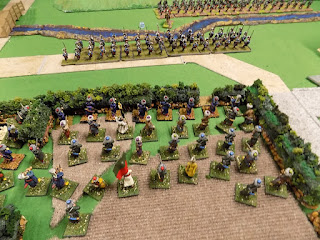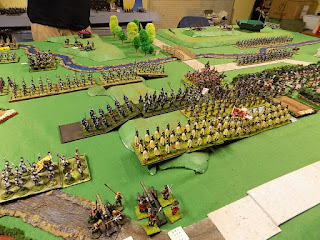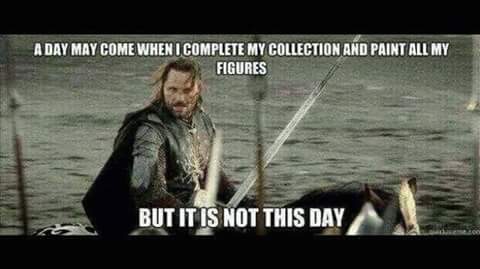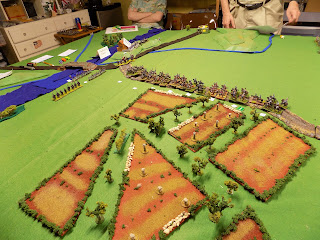In our Imagi-Nation world, the combined armies of Odessenau and Latveria have invaded Vaneria and are moving on a strategically located city along a critical river. Vaneria was a Russian position that was taken by the Ottomans and has reached semi-independent status over the decades of benevolent rule. On each flank are smaller forces to protect the besiegers from relief efforts. Looking to back a winner, Prochistan has joined the invaders, looking for rewards at the end of the campaign. Similarly, Austria not wanting to see a stronger Odessenau, has taken their own interests at heart and have sent an expeditionary force to help maintain the power balance.
Near the picturesque village of Hinten-Anzehn-Dingle the opposing forces find each other. Rules are Batailles de l'Ancien Regime (BAR) by Bill Protz. Figure ratio is 10:1 and the order of movement and firing is determined by cards. In our case today, by Brigade.
 |
| The village of Hinten-Anzehn-Dingle knows nothing of the coming storm. |
 |
| Batailles de l'Ancien Regime as noted above. |
 |
| Closer view of town. Mostly paper models with some 3D printed. |
 |
| The townsfolk rejoice at the sight of Vanerian troops. |
 |
| A delegation turns out to welcome them. |
 |
| The initial set on. More are on the back tables. |
 |
| Meanwhile, the sinister forces of Odessenau and Prochistan approach, leading a flank force. |
 |
| The stream is but a minor hinderance to movement. |
 |
| On the left, Austrian allies enjoy the morning sun. |
 |
| Soon each side has eight infantry regiments of 60 figures and eight cavalry squadrons of 12 figures each, in play. |
 |
| The more open ground on the defenders left seems to favor cavalry the best. |
 |
| Some squadrons drift into musket range, to their demise. |
 |
| A Vanerian light regiment shelters behind a bocage-like hedge, getting serious cover. |
 |
| The Prochistan forces are very aggressive and attack the bocage and their cavalry charges steady infantry. |
 |
| The invaders are eagerly attacking with their cavalry, the Austrians and Vanerians have theirs supporting. |
 |
| The feared winged hussars of Prochistan and Odessenau infantry take hurts, but slowly push back the Vanerians onto their supports, the white cloaked grenadiers. |
 |
| The Vanerian lights are repeatedly charged by Prochistan infantry but manage to hold off assaults through their heavy cover. |
 |
| Similarly, the Prochistans are assaulting the village in bitter, house to house fighting, leaving disordered mobs to move from building to building. |
 |
| On the defender's left, a big cavalry scrum erupts between the Austrians and the weakened Odessenau cavalry. |
 |
| The winged hussars destroy themselves trying to break the Vanerians, who somehow hold. For now. |
 |
| The Austrian infantry begins to sort itself out and move forward with hostile intent. |
 |
| On the defender's right, the Tatars move to strike the disordered invaders. |
 |
| The other Vanerian cavalry moves to the left to support the advancing Austrians. Along the way they eliminate some previously victorious Odessenau cavalry. |
 |
| Odessenau resorts to desperate tactics, firing through their own battery at the advancing Austrians, eliminating it. |
 |
| The action filled center. Invaders on the right, some infantry reordering. Note: for our game the light infantry was not allowed to take the close order. |
 |
| Loudon's "Green Grenadiers" (just line) advance to complete the discomfort of the Odessenau line. |
 |
| To try to stave off disaster, the (real) Austrian grenadiers are charged by dragoons and infantry. All to no avail. |
 |
| Prochistan is finally successful driving the Vanaerian lights off the bocage. If caught in the open, they will be eliminated without a fight. |
 |
| The dragoon remnants are thrown back but somehow pass morale. |
 |
| The defenders are now fully the attackers on their left, with the Austrian hussars, previously held back, moving to mop up. |
 |
| A final long view of the table from the Austrian end. |




















